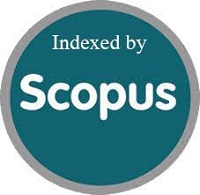Uji Validitas Konstruk Skala Religious and Spiritual Struggles
DOI:
https://doi.org/10.15408/jp3i.v8i2.12969Keywords:
Construct Validity, Validitas Konstruk, Religious and Spiritual StrugglesAbstract
Abstract
Many people face struggles around the religious and spiritual aspects of daily life, as shown by increasingly researches that have been being carried out. The more research develops on these two variables, the more comprehensive, reliable and concise measurement of someone's struggle in term of religion and spirituality through a multiple domain scale are needed. Religious and spiritual struggles occur when some aspects of religious belief, practice or experience become a negative focus so that it is closely related to emotions, concerns, or conflicts. There are six dimensions in religious and spiritual struggles, namely divine, demonic, interpersonal struggle, morality, ultimate meaning, and doubt. The aim of this study is to test the construct validity of Religious and Spiritual Struggles scale. 26 items of the Religious and Spiritual Struggle are tested. 150 college students are participated in this research. By using confirmatory factor analysis and helped by LISREL 8.70 software, the result shows that all dimensions have a fit model and truly measure religious and spiritual struggles even though there is one item in moral dimension that must be dropped.
Abstrak
Banyak orang mengalami pergulatan seputar aspek religius dan spiritual dalam kehidupan sehari-hari, sebagaimana ditunjukkan oleh penelitian-penelitian yang semakin luas dilakukan. Semakin berkembangnya penelitian terkait dua variabel ini semakin meningkat pula kebutuhan akan pengukuran yang lebih komprehensif, reliabel, dan ringkas tentang perjuangan seseorang dalam hal agama dan spiritualitas melalui skala yang mencakup banyak domain. Religious and spiritual struggles terjadi ketika beberapa aspek kepercayaan, praktik, atau pengalaman religius menjadi fokus negatif sehingga ia terkait erat dengan emosi, kekhawatiran, atau konflik. Terdapat enam dimensi dalam religious and spiritual struggles yaitu divine, demonic, interpersonal struggles, moral, ultimate meaning, dan doubt. Tujuan dari penelitian ini adalah untuk menguji validitas konstruk dari skala Religious and Spiritual Struggles. Terdapat 26 item dalam skala ini. Responden dalam penelitian ini sebanyak 150 mahasiswa. Metode analisis faktor yang digunakan dalam penelitian ini adalah CFA (confirmatory factor analysis) dengan bantuan perangkat lunak LISREL 8.70. Hasilnya, seluruh dimensi memiliki model yang fit dan benar-benar mengukur religious and spiritual struggles meskipun ada satu item pada dimensi moral yang harus di drop.
References
Ano, G. G., & Vasconcelles, E. B. (2005). Religious coping and psychological adjustment to stress: A meta-analysis. Journal of Clinical Psychology, 61, 461–480. doi:10.1002/jclp.20049
Azwar, S. (2012). Penyusunan Skala Psikologi. Yogyakarta: Pustaka Pelajar.
Bryant, A. N., & Astin, H. S. (2008). The correlates of spiritual struggle during the college years. Journal of Higher Education, 79, 1–27. doi: 10.1353/jhe.2008.0000
Ellison, C. G., & Lee, J. (2010). Spiritual struggles and psychological distress: Is there a dark side of religion? Social Indicators Research, 98, 501–517. doi:10.1007/s11205-009-9553-3
Exline, J. J., Yali, A. M., & Sanderson, W. C. (2000). Guilt, discord, and alienation: The role of religious strain in depression and suicidality. Journal of Clinical Psychology, 56, 1481-1496. doi:10.1002/1097-4679(200012)56:12_1481::AID-1_3.0.CO;2-A
Exline, J.J., Pargament, K.I., Grubbs, J.B., Yali, A.M. (2014). The religious and spiritual struggles scale: Development and initial validations. Psychology of Religion and Spirituality. 6 (3): 208-222.
Ghufron, N., & Risnawati, R.S. (2011). Teori-teori Psikologi. Jakarta: Ar-Ruzz Media.
McConnell, K. M., Pargament, K. I., Ellison, C. G., & Flannelly, K. J. (2006). Examining the links between spiritual struggles and symptoms of psychopathology in a national sample. Journal of Clinical Psychology, 62, 1469–1484. doi:10.1002/jclp.20325
McCullough, M. E., & Willoughby, B. L. B. (2009). Religion, self-regulation, and self-control: Associations, explanations, and implications. Psychological Bulletin, 135, 69–93. doi:10.1037/a0014213
Pargament, K. I. (2007). Spiritually integrated psychotherapy: Understanding and addressing the sacred. New York: Guilford Press.
Pargament, K. I., Murray-Swank, N., Magyar, G. M., & Ano, G. G. (2005). Spiritual struggle: A phenomenon of interest to psychology and religion. In W. R. Miller & H. Delaney (Eds.), Judeo-Christian perspectives on psychology: Human nature, motivation, and change (pp. 245–268). Washington, DC: APA Books. doi:10.1037/10859-013
Pargament, K. I., Koenig, H. G., Tarakeshwar, N., & Hahn, J. (2001). Religious struggle as a predictor of mortality among medically ill elderly patients: A two-year longitudinal study. Archives of Internal Medicine, 161, 1881–1885. doi:10.1001/archinte.161.15.1881
Park, C. L., Brooks, M. A., & Sussman, J. (2009). Dimensions of religion and spirituality in psychological adjustment of older adults living with congestive heart failure. In A. L. Ai & M. Ardelt (Eds.), Faith and well-being in later life (pp. 41–58). Hauppauge, NY: Nova Science.
Tischler, L. (2002). Linking emotional intelligence, spirituality and workplace performance: Defenitions, models, and ideas for research. Journal of Managerial Psychology. 17 (3): 203.
Umar, J. (2012). Confirmatory Factor Analysis (Bahan Ajar Perkuliahan). Jakarta: UIN Syarif Hidayatullah.



